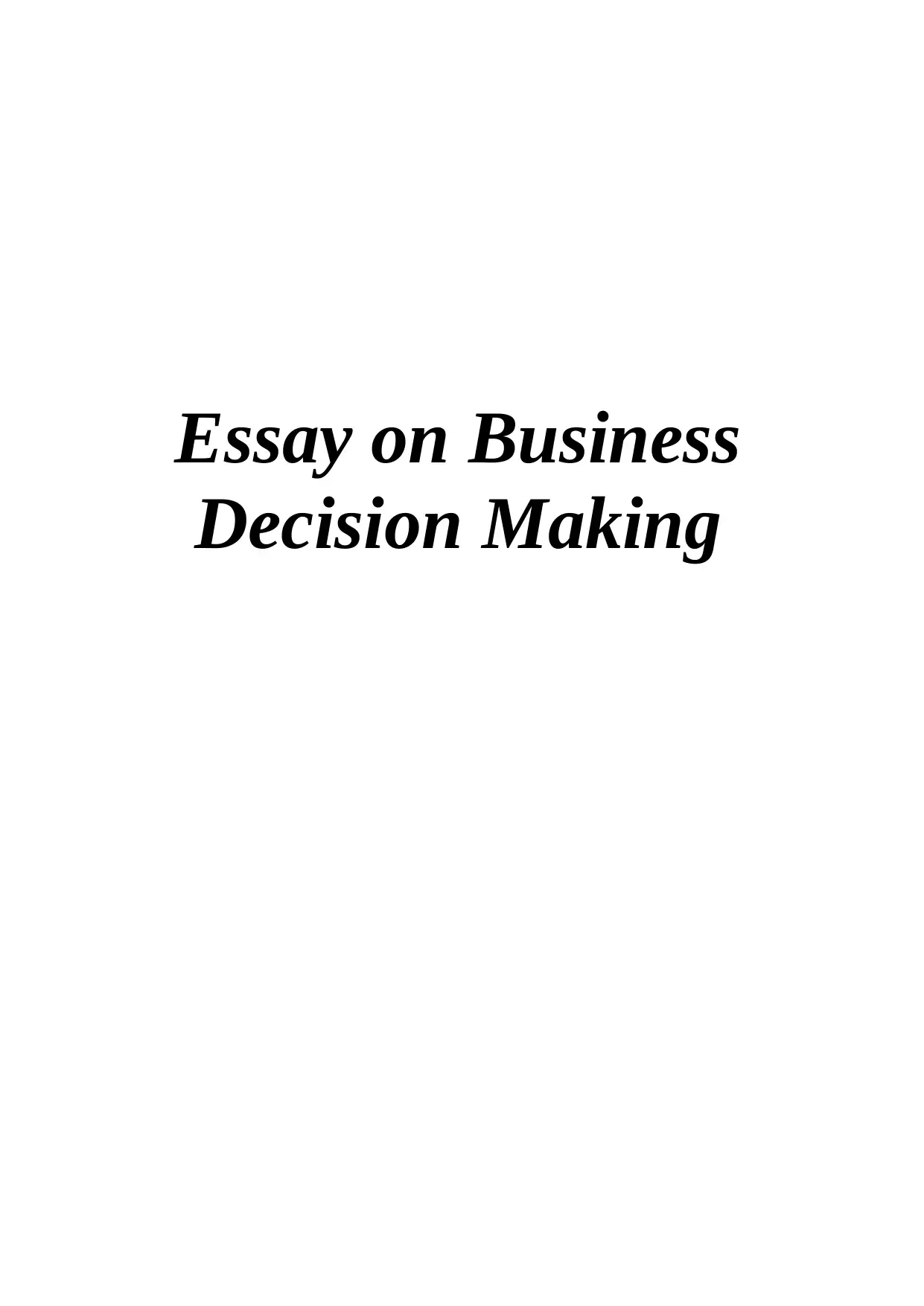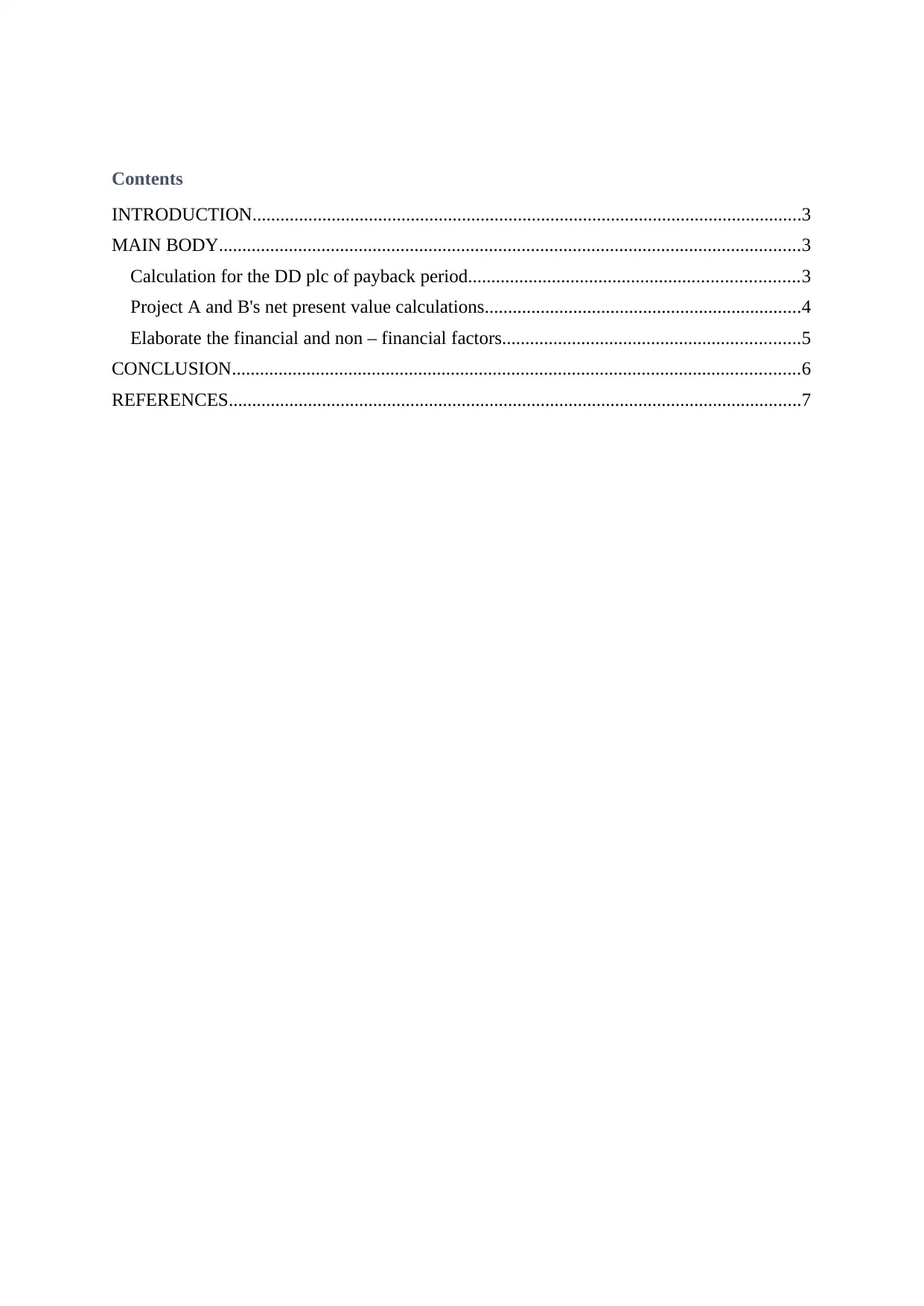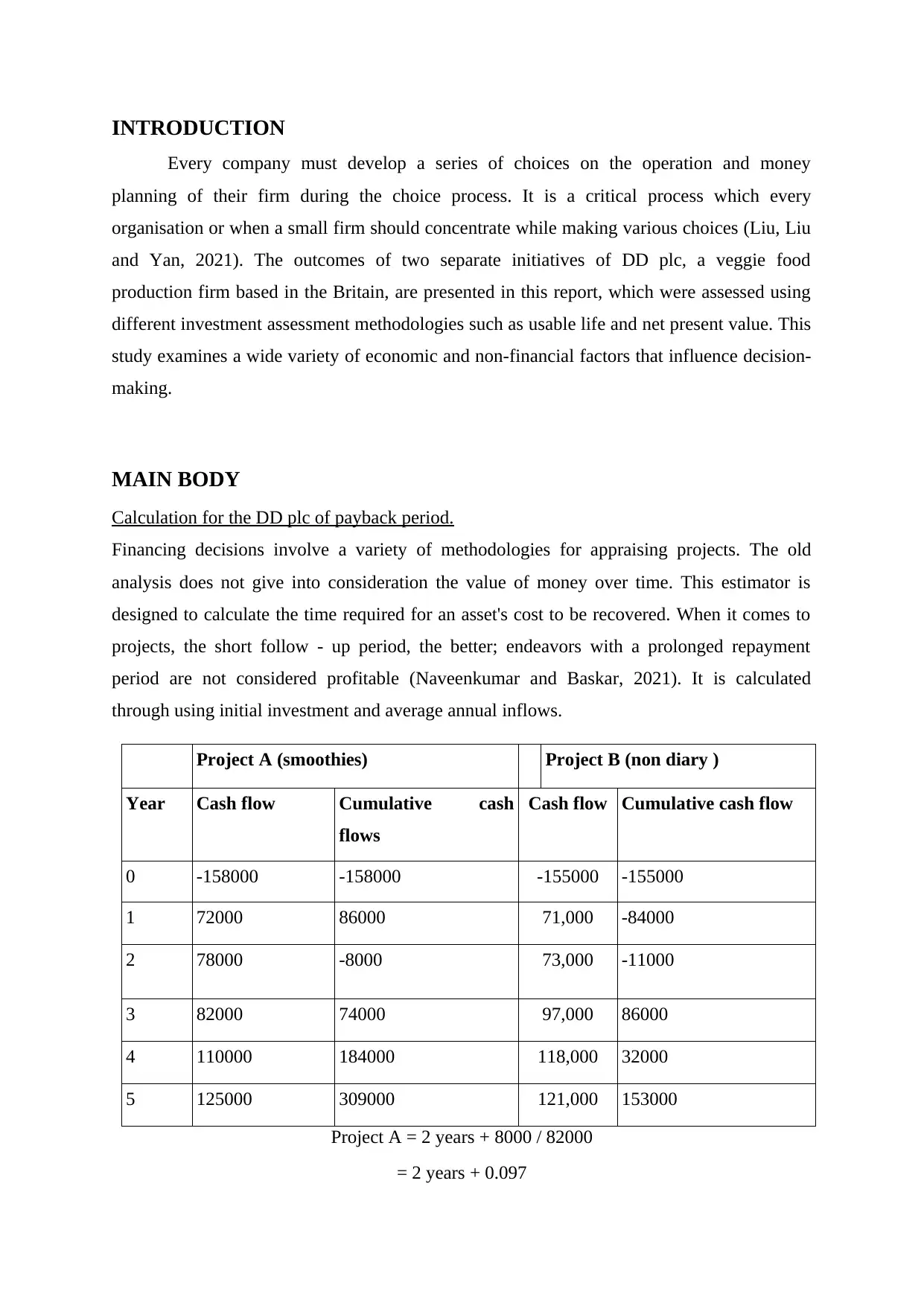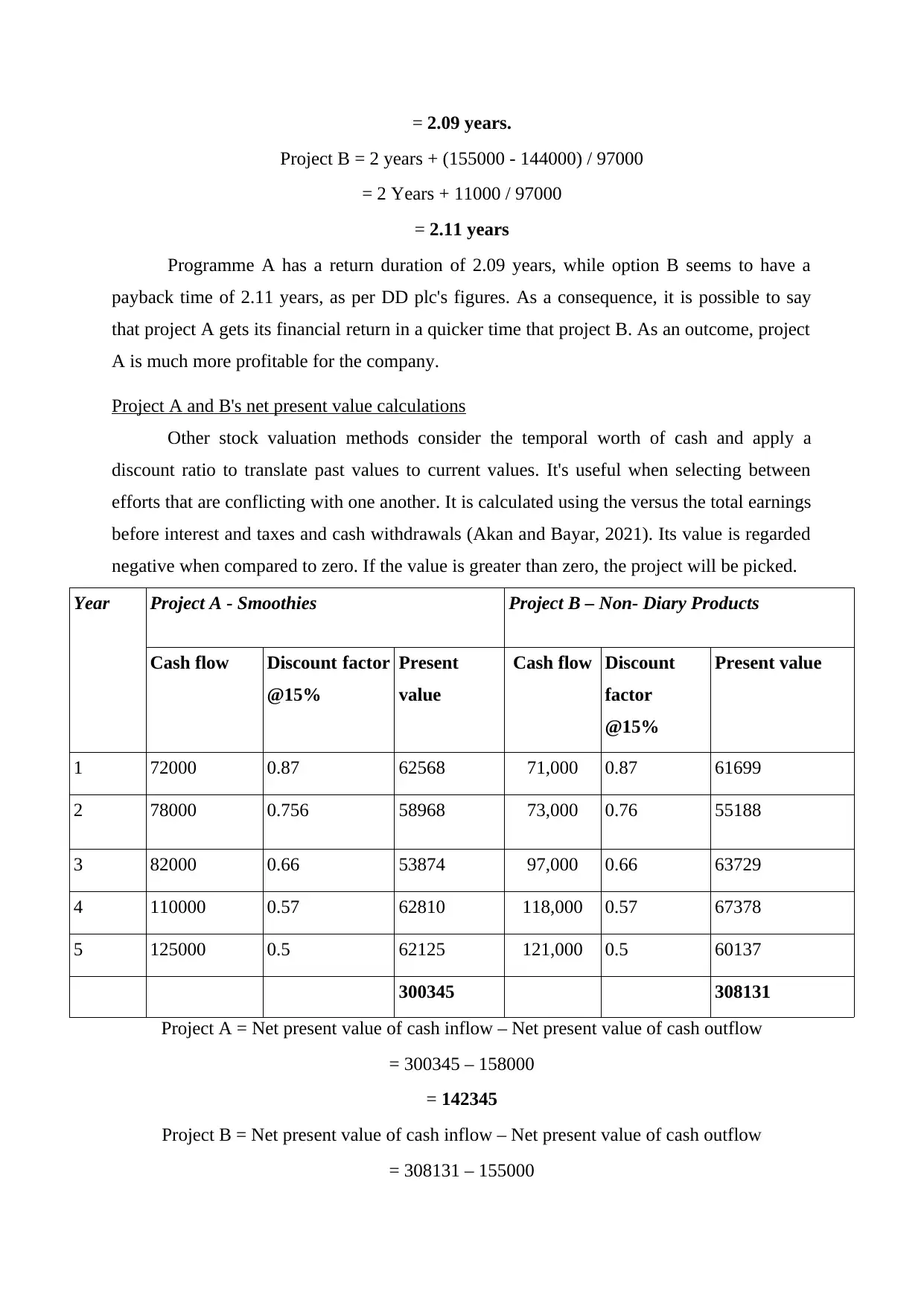DD plc Investment Appraisal: Financial & Non-Financial Factors Essay
VerifiedAdded on 2023/06/14
|7
|1305
|188
Essay
AI Summary
This essay provides an analysis of business decision-making, focusing on the financial and non-financial factors that influence investment choices. It examines two potential projects for DD plc, a veggie food production firm, using investment appraisal methods such as payback period and net present value (NPV). The payback period calculation reveals that Project A has a shorter payback period, while NPV calculations indicate that Project B has a higher net present value. The essay further elaborates on various financial factors like liquidity, debt, and capital structure, as well as non-financial factors such as governmental regulations and customer relationships, highlighting their impact on business outcomes. The conclusion emphasizes the importance of corporate finance tools in making informed decisions and mitigating the effects of various factors.

Essay on Business
Decision Making
Decision Making
Paraphrase This Document
Need a fresh take? Get an instant paraphrase of this document with our AI Paraphraser

Contents
INTRODUCTION......................................................................................................................3
MAIN BODY.............................................................................................................................3
Calculation for the DD plc of payback period.......................................................................3
Project A and B's net present value calculations....................................................................4
Elaborate the financial and non – financial factors................................................................5
CONCLUSION..........................................................................................................................6
REFERENCES...........................................................................................................................7
INTRODUCTION......................................................................................................................3
MAIN BODY.............................................................................................................................3
Calculation for the DD plc of payback period.......................................................................3
Project A and B's net present value calculations....................................................................4
Elaborate the financial and non – financial factors................................................................5
CONCLUSION..........................................................................................................................6
REFERENCES...........................................................................................................................7

INTRODUCTION
Every company must develop a series of choices on the operation and money
planning of their firm during the choice process. It is a critical process which every
organisation or when a small firm should concentrate while making various choices (Liu, Liu
and Yan, 2021). The outcomes of two separate initiatives of DD plc, a veggie food
production firm based in the Britain, are presented in this report, which were assessed using
different investment assessment methodologies such as usable life and net present value. This
study examines a wide variety of economic and non-financial factors that influence decision-
making.
MAIN BODY
Calculation for the DD plc of payback period.
Financing decisions involve a variety of methodologies for appraising projects. The old
analysis does not give into consideration the value of money over time. This estimator is
designed to calculate the time required for an asset's cost to be recovered. When it comes to
projects, the short follow - up period, the better; endeavors with a prolonged repayment
period are not considered profitable (Naveenkumar and Baskar, 2021). It is calculated
through using initial investment and average annual inflows.
Project A (smoothies) Project B (non diary )
Year Cash flow Cumulative cash
flows
Cash flow Cumulative cash flow
0 -158000 -158000 -155000 -155000
1 72000 86000 71,000 -84000
2 78000 -8000 73,000 -11000
3 82000 74000 97,000 86000
4 110000 184000 118,000 32000
5 125000 309000 121,000 153000
Project A = 2 years + 8000 / 82000
= 2 years + 0.097
Every company must develop a series of choices on the operation and money
planning of their firm during the choice process. It is a critical process which every
organisation or when a small firm should concentrate while making various choices (Liu, Liu
and Yan, 2021). The outcomes of two separate initiatives of DD plc, a veggie food
production firm based in the Britain, are presented in this report, which were assessed using
different investment assessment methodologies such as usable life and net present value. This
study examines a wide variety of economic and non-financial factors that influence decision-
making.
MAIN BODY
Calculation for the DD plc of payback period.
Financing decisions involve a variety of methodologies for appraising projects. The old
analysis does not give into consideration the value of money over time. This estimator is
designed to calculate the time required for an asset's cost to be recovered. When it comes to
projects, the short follow - up period, the better; endeavors with a prolonged repayment
period are not considered profitable (Naveenkumar and Baskar, 2021). It is calculated
through using initial investment and average annual inflows.
Project A (smoothies) Project B (non diary )
Year Cash flow Cumulative cash
flows
Cash flow Cumulative cash flow
0 -158000 -158000 -155000 -155000
1 72000 86000 71,000 -84000
2 78000 -8000 73,000 -11000
3 82000 74000 97,000 86000
4 110000 184000 118,000 32000
5 125000 309000 121,000 153000
Project A = 2 years + 8000 / 82000
= 2 years + 0.097
⊘ This is a preview!⊘
Do you want full access?
Subscribe today to unlock all pages.

Trusted by 1+ million students worldwide

= 2.09 years.
Project B = 2 years + (155000 - 144000) / 97000
= 2 Years + 11000 / 97000
= 2.11 years
Programme A has a return duration of 2.09 years, while option B seems to have a
payback time of 2.11 years, as per DD plc's figures. As a consequence, it is possible to say
that project A gets its financial return in a quicker time that project B. As an outcome, project
A is much more profitable for the company.
Project A and B's net present value calculations
Other stock valuation methods consider the temporal worth of cash and apply a
discount ratio to translate past values to current values. It's useful when selecting between
efforts that are conflicting with one another. It is calculated using the versus the total earnings
before interest and taxes and cash withdrawals (Akan and Bayar, 2021). Its value is regarded
negative when compared to zero. If the value is greater than zero, the project will be picked.
Year Project A - Smoothies Project B – Non- Diary Products
Cash flow Discount factor
@15%
Present
value
Cash flow Discount
factor
@15%
Present value
1 72000 0.87 62568 71,000 0.87 61699
2 78000 0.756 58968 73,000 0.76 55188
3 82000 0.66 53874 97,000 0.66 63729
4 110000 0.57 62810 118,000 0.57 67378
5 125000 0.5 62125 121,000 0.5 60137
300345 308131
Project A = Net present value of cash inflow – Net present value of cash outflow
= 300345 – 158000
= 142345
Project B = Net present value of cash inflow – Net present value of cash outflow
= 308131 – 155000
Project B = 2 years + (155000 - 144000) / 97000
= 2 Years + 11000 / 97000
= 2.11 years
Programme A has a return duration of 2.09 years, while option B seems to have a
payback time of 2.11 years, as per DD plc's figures. As a consequence, it is possible to say
that project A gets its financial return in a quicker time that project B. As an outcome, project
A is much more profitable for the company.
Project A and B's net present value calculations
Other stock valuation methods consider the temporal worth of cash and apply a
discount ratio to translate past values to current values. It's useful when selecting between
efforts that are conflicting with one another. It is calculated using the versus the total earnings
before interest and taxes and cash withdrawals (Akan and Bayar, 2021). Its value is regarded
negative when compared to zero. If the value is greater than zero, the project will be picked.
Year Project A - Smoothies Project B – Non- Diary Products
Cash flow Discount factor
@15%
Present
value
Cash flow Discount
factor
@15%
Present value
1 72000 0.87 62568 71,000 0.87 61699
2 78000 0.756 58968 73,000 0.76 55188
3 82000 0.66 53874 97,000 0.66 63729
4 110000 0.57 62810 118,000 0.57 67378
5 125000 0.5 62125 121,000 0.5 60137
300345 308131
Project A = Net present value of cash inflow – Net present value of cash outflow
= 300345 – 158000
= 142345
Project B = Net present value of cash inflow – Net present value of cash outflow
= 308131 – 155000
Paraphrase This Document
Need a fresh take? Get an instant paraphrase of this document with our AI Paraphraser

= 153131
The NPV of project A is 142345, while of project B is 153131. Option B has a higher
net present value than Project A. As a result, among the two initiatives described previously,
plan B will be picked.
Elaborate the financial and non – financial factors.
Other investment evaluation methods consider the time worth of money and apply a
discounted ratio to convert past values to current values. Every organisation creates its own
set of standards, that are then contrasted to the true ones. Performance measurement can
detect deviations in performance, and top-level management can rewrite the plan to correct
them. The following are some of the financial and non-financial topics that can be discussed:
Financial variables: Liquidity, debt, and the company's organization structures are
all factors that influence the performance of the company. Capital structure decisions
determine the percentage of equity and debt utilised to finance the company.
Increasing debt inside a business lowers the cost of financing and increases the value
of the company (Jessri, Kosmidou and Ahuja, 2020). As a result, determining the cost
and worth of a company can help with a range of financing options. Liquidity is
necessary for a company's operations to run properly.
Liquid assets is ones that can be turned into cash quickly. The organization's
main issue is to maintain an optimal level of liquidity. A significant rise in the price of
money is characterized as inflation. A huge rise in product rates in the market has an
effect on the government's money supply. It has an effect on the purchasing power of
customers.
Non-financial variables: The aspects which have an incidental effect on the outcome
process as follows: Every country plays the laws and regulations imposed by that
nation's leader. Governmental structural reforms have had an impact on business
operations. Tariff rate hikes, for instance, restrict firms in the retail that, as a
corollary, reduce operational efficiency. The plans of an organisation should be
adaptable enough that variations have no impact on the firm's earnings (Shabbir and
et.al., 2020). Improved client encounters improve promotional activities and boosts
consumer confidence. A special emphasis should not only be on profitability, but also
on building a pleasant relationship with its customers.
The NPV of project A is 142345, while of project B is 153131. Option B has a higher
net present value than Project A. As a result, among the two initiatives described previously,
plan B will be picked.
Elaborate the financial and non – financial factors.
Other investment evaluation methods consider the time worth of money and apply a
discounted ratio to convert past values to current values. Every organisation creates its own
set of standards, that are then contrasted to the true ones. Performance measurement can
detect deviations in performance, and top-level management can rewrite the plan to correct
them. The following are some of the financial and non-financial topics that can be discussed:
Financial variables: Liquidity, debt, and the company's organization structures are
all factors that influence the performance of the company. Capital structure decisions
determine the percentage of equity and debt utilised to finance the company.
Increasing debt inside a business lowers the cost of financing and increases the value
of the company (Jessri, Kosmidou and Ahuja, 2020). As a result, determining the cost
and worth of a company can help with a range of financing options. Liquidity is
necessary for a company's operations to run properly.
Liquid assets is ones that can be turned into cash quickly. The organization's
main issue is to maintain an optimal level of liquidity. A significant rise in the price of
money is characterized as inflation. A huge rise in product rates in the market has an
effect on the government's money supply. It has an effect on the purchasing power of
customers.
Non-financial variables: The aspects which have an incidental effect on the outcome
process as follows: Every country plays the laws and regulations imposed by that
nation's leader. Governmental structural reforms have had an impact on business
operations. Tariff rate hikes, for instance, restrict firms in the retail that, as a
corollary, reduce operational efficiency. The plans of an organisation should be
adaptable enough that variations have no impact on the firm's earnings (Shabbir and
et.al., 2020). Improved client encounters improve promotional activities and boosts
consumer confidence. A special emphasis should not only be on profitability, but also
on building a pleasant relationship with its customers.

CONCLUSION
The following findings suggest that corporate finance tools aid in making important
decisions about the viability of diverse programs. It represents the payout amount given to
owners. Although the benefits of economic and non-financial components cannot be
regulated, there seem to be a number of steps that can be taken to mitigate the effect of
various factors or gained wide attention.
The following findings suggest that corporate finance tools aid in making important
decisions about the viability of diverse programs. It represents the payout amount given to
owners. Although the benefits of economic and non-financial components cannot be
regulated, there seem to be a number of steps that can be taken to mitigate the effect of
various factors or gained wide attention.
⊘ This is a preview!⊘
Do you want full access?
Subscribe today to unlock all pages.

Trusted by 1+ million students worldwide

REFERENCES
Books and Journals
Akan, E. and Bayar, S., 2021. An evaluation of ship investment in interval type-2 fuzzy
environment. Journal of the Operational Research Society. pp.1-19.
Jessri, M., Kosmidou, V. and Ahuja, M.K., 2020. Employees’ decision to participate in
corporate venturing: A conjoint experiment of financial and non-financial
motivations. Journal of Business Venturing Insights. 13. p.e00161.
Liu, R., Liu, M. and Yan, J., 2021. Techno-economic analysis of the lignite-fired power plant
integrated with a steam or flue gas dryer. Drying Technology. 39(10). pp.1271-1284.
Naveenkumar, R. and Baskar, G., 2021. Process optimization, green chemistry balance and
technoeconomic analysis of biodiesel production from castor oil using
heterogeneous nanocatalyst. Bioresource Technology. 320. p.124347.
Shabbir, M.S. and et.al., 2020. Nexus between corporate social responsibility and financial
and non-financial sectors’ performance: a non-linear and disaggregated
approach. Environmental Science and Pollution Research. 27(31). pp.39164-39179.
Books and Journals
Akan, E. and Bayar, S., 2021. An evaluation of ship investment in interval type-2 fuzzy
environment. Journal of the Operational Research Society. pp.1-19.
Jessri, M., Kosmidou, V. and Ahuja, M.K., 2020. Employees’ decision to participate in
corporate venturing: A conjoint experiment of financial and non-financial
motivations. Journal of Business Venturing Insights. 13. p.e00161.
Liu, R., Liu, M. and Yan, J., 2021. Techno-economic analysis of the lignite-fired power plant
integrated with a steam or flue gas dryer. Drying Technology. 39(10). pp.1271-1284.
Naveenkumar, R. and Baskar, G., 2021. Process optimization, green chemistry balance and
technoeconomic analysis of biodiesel production from castor oil using
heterogeneous nanocatalyst. Bioresource Technology. 320. p.124347.
Shabbir, M.S. and et.al., 2020. Nexus between corporate social responsibility and financial
and non-financial sectors’ performance: a non-linear and disaggregated
approach. Environmental Science and Pollution Research. 27(31). pp.39164-39179.
1 out of 7
Related Documents
Your All-in-One AI-Powered Toolkit for Academic Success.
+13062052269
info@desklib.com
Available 24*7 on WhatsApp / Email
![[object Object]](/_next/static/media/star-bottom.7253800d.svg)
Unlock your academic potential
Copyright © 2020–2025 A2Z Services. All Rights Reserved. Developed and managed by ZUCOL.



